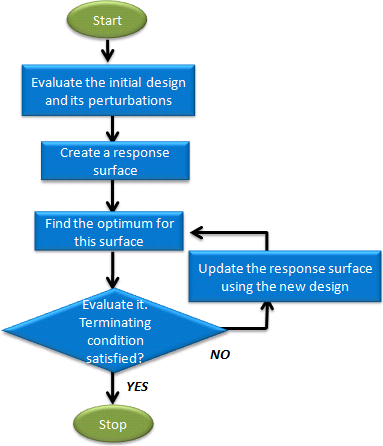Setting
|
Default
|
Range
|
Description
|
Initial linear move
(MPERT)
|
By DV Initial
|
By DV Initial or By DV Bounds
|
By DV initial.
|
Initial move = PERT * MOVE * abs(INI)
(Default when initial value of input variable is non-zero)
An exception is that initial move will be set to minimum move if it is less than minimum move.
Minimum move = MINMOVE * (UB-LB) if (UB-LB) is less than 1.
Minimum move = MINMOVE if (UB-LB) is not less than 1 and absolute value of INI is less than 1.
Minimum move = MINMOVE * min((UB-LB),abs(INI)) if (UB-LB) is not less than 1 and absolute value of INI is not less than 1.
|
By DV bounds.
|
Initial move = PERT * MOVE * (UB-LB)
(Default when initial value of input variable is zero)
|
INI Initial input variable value
LB, UB Lower and upper bounds on input variable
|
Move limit fraction
(MOVE)
|
0.15
|
0.0 < MOVE < 1.0
|
Move limit fraction.
Smaller value allow more steadily convergence (smaller fluctuation of the output response values), but more computational effort could be consumed. The value will be adaptively updated during optimization process.
|
Initial DV perturbation
(PERT)
|
1.1
|
≠ 0.0
|
Initial input variable perturbation value.
Larger value results in wider spread of the initial N designs ( is the number of input variables; the is the number of input variables; the  designs together with the start design can determine a linear response surface). ARSM will search the design space more widely. designs together with the start design can determine a linear response surface). ARSM will search the design space more widely.
|
Constraint screening (%)
(CONRET)
|
50.0
|
real value
|
Constraint Screening.
|
> 0.0
|
Constraint is retained (not screened out) if it is violated or within the given percentage of its critical value (bound).
|
< 0.0
|
As many constraints are retained as memory permits.
|
Minimal Move Factor
(MINMOVE)
|
0.1
|
0.0 < MINMOVE < MOVE
|
Minimal move factor. It is to avoid too small of the step size. It is used in the initial sampling step (See the usage of MINMOVE in MPERT) and also in the preceding move limit strategy.
|
Response surface
(TPARSM)
|
SORS
|
SORS,
SRSM
|
SORS= Second order response surface (SORS) is used.
SRSM= Scalable response surface method (SRSM) is used.
SRSM is used, the limit on MAXDES >= N+2 should be deleted, where N is number of input variables.
When there are a lot of input variables and the computational effort is limited, SRSM is a good choice.
|
Solver
(OPTARSM)
|
SQP
|
MFD,
SQP,
Hybrid
|
Method ARSM uses to solve the response surface based optimization problem.
It is recommended to use 2 when there are a lot of discrete variables.
|
Points per Iteration
(PARALLE)
|
1
|
> 0
|
Controls the number of points used in an iteration after the first iteration. The number of points used per iteration can result in different iteration histories.
|
Sample points
(NPTSRS)
|
0
|
>=0
|
0
|
Automatically determined; in SRSM, NPTSRS is set to  . .  is the number of input variables. is the number of input variables.
|
>0
|
Use the user defined value.
|
NPTSRS is useful only if TPARSM = 1.
|
Use SVD
(SVDRSM)
|
False
|
False or
True
|
This parameter can be useful in case of soft convergence. In case of soft convergence:
| • | if Use SVD is false, ARSM is terminated. |
| • | if Use SVD is true, Singular Value Decomposition is activated to re-build the response surfaces and optimization process will be continued. |
|
Revision
(VERARSM)
|
A-multi
|
A-multi and B-multi
|
This parameter is used to help when there is a convergence difficulty. By default, "A-multi" is selected meaning the legacy algorithm.
| Note: | A-multi and B-multi are new versions of A and B that support multi-execution. The classification of iteration points is different between A and A-multi (and B and B-multi). |
|
Constraint threshold
(EPSCON)
|
1.0e-4
|
> 0.0
|
This parameter is used for constraint value calculation. In general, constraint value is normalized to its bound value. One exception is that constraint value is not normalized if its absolute bound value is less than this parameter. Recommended range is 1.0e-6 ~ 1.0.
|
Use Inclusion Matrix
(INCLUSI)
|
No
|
No, With Initial, Without Initial
|
| • | No ignores the Inclusion matrix |
| • | With Initial runs the initial point. The best point of the inclusion or the initial point is used as the starting point. |
| • | Without Initial does not run the initial point. The best point of the inclusion is used as the starting point. |
|








